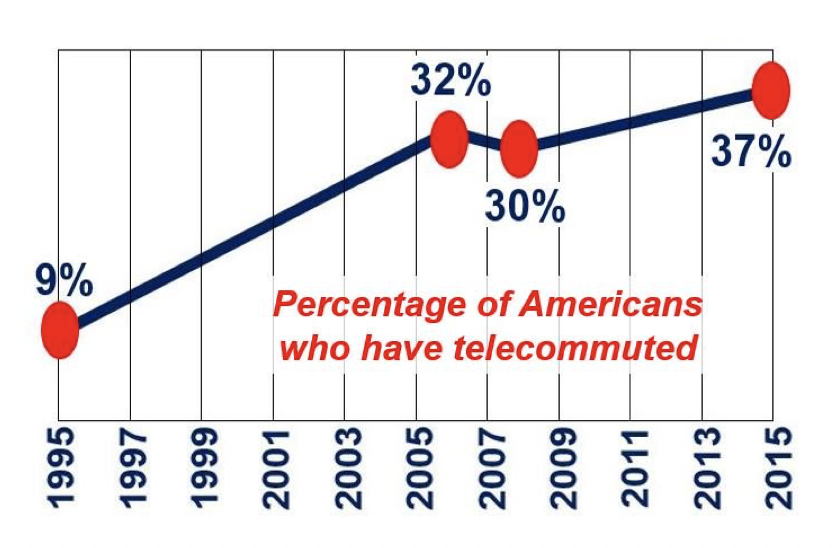Teleworking, also known as telecommuting, means working from home or remotely using modern technology and telecommunications to remain in touch with your employer or business. Teleworking allows individuals to work either at home, at a local cafe with WiFi, or at a local telework center for one or more days each week, or full-time.
The teleworker uses communication tools to carry out work duties from a remote location. Over the past twenty years, the practice has become much more common. The term remote working also means the same as teleworking.
The trend towards teleworking has been accelerated by advancements in cloud computing, allowing for seamless collaboration and access to company resources from any location.

Equipment and tech
In order to function effectively as a teleworker, you will need the following equipment and technology:
- a computer
- an email account
- an account with a service that provides video teleconferencing (not always necessary)
- a smartphone
- a fax machine (not always necessary)
Teleworking advantages for the employer
- Reduced office running costs and overheads such as office space, electricity, heating and other utilities.
- Fewer travel-related problems. For example, staff not affected by bus or train strikes, or bad weather.
- Wider choice of candidates for recruitment. With teleworking, the employer can choose candidates from anywhere in the country, and also across the world.

-
Flexible schedules
With flexible schedules, i.e., people working outside the traditional 9-to-5 period, companies can become 24-hour operations. For many firms, this could mean more revenue and business opportunities.
The employer needs to make sure that the worker is fully capable of working at home at least as effectively as at the office. The teleworker must be trusted – this is a risk for the employer (and the worker).
Some people do not function well if they are not physically supervised. The employer needs to be prepared to have less control over the employee who is working from home.
Teleworking advantages for the worker
- You can get up later, because ‘traveling’ from your bed to your home workstation is a very short distance.
- You work in a comfortable environment; your home.
- No traveling outside to and from work.
- No work-related travel costs.
- It is easier to work around your family’s needs.
- If you are self-employed or run your own business, you don’t need to spend money on a premises.

Less office camaraderie
If you do decide to work from home, bear in mind that you will have less interaction with other colleagues. There will be fewer opportunities to meet others, bounce ideas off each other, forget about your personal problems with some office banter or after-work get-togethers, etc.
If most of your other team members work at the office, you may find yourself eventually becoming the ‘outsider’ – you might find it harder to work as a fully-integrated team member.
If you prefer separating your personal life from work, teleworking may not be for you. Bear in mind that you will be spending considerably more time ‘immersed’ in your personal life.
A teleworker needs to be a self-motivated person. There will be nobody there motivating you to carry out your duties properly and on time. Are you that kind of person? Can you work successfully under your own steam?

Teleworking becoming more common
The average US employee was teleworking for two days each month last year. The majority of employers said their teleworkers were just as productive as their in-office personnel.
The number of individuals working from home has been increasing dramatically since the advent of the Internet. Over the past decade in the United Kingdom, the number of people who are full-time teleworkers has increased to one in seven of all employees.

In 2015, there were over four million teleworking employees in the UK, representing 13.7% of the total workforce. Experts say this percentage will increase considerably over the next decade.
Technology has made teleworking easier for employees. The majority of companies seem willing to allow their workers do carry out their duties remotely, at least on a part-time basis if their position allows for it.
The flexibility offered by teleworking arrangements is not only advantageous to employees, but it also provides employers with access to a broader talent pool, unrestricted by geographic limitations.
Effect of the pandemic
The COVID-19 pandemic, spanning 2020-2022, and the subsequent lockdowns significantly boosted teleworking rates in the US, UK, other advanced economies, and many emerging economies.
This shift was driven by the necessity to maintain business continuity while adhering to social distancing measures.
Although these rates slightly decreased post-pandemic, the number of people working remotely worldwide today remains higher than before 2020. This enduring change highlights a transformation in the global workforce’s approach to work, suggesting a lasting impact of the pandemic on workplace norms and practices.
